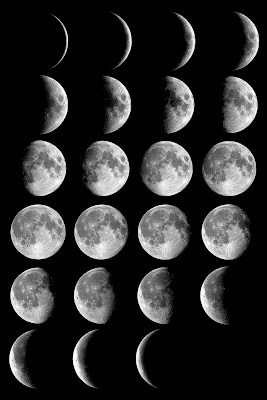Monday Muse: The Phases of the Moon

Much ado is made about full moons and the mayhem that ensues surrounding them. Full moons are actually that period of growth that brings everything to the fore and not necessarily evil. It is the dark of the moon that is deceitful and not the time for setting things in motion.
As moonconnection.com explains: "...the new moon occurs when the moon is positioned between the earth and sun. The three objects are in approximate alignment (why "approximate" is explained below). The entire illuminated portion of the moon is on the back side of the moon, the half that we cannot see.
At a full moon, the earth, moon, and sun are in approximate alignment, just as the new moon, but the moon is on the opposite side of the earth, so the entire sunlit part of the moon is facing us. The shadowed portion is entirely hidden from view.
The first quarter and third quarter moons (both often called a "half moon"), happen when the moon is at a 90 degree angle with respect to the earth and sun. So we are seeing exactly half of the moon illuminated and half in shadow.
Once you understand those four key moon phases, the phases between should be fairly easy to visualize, as the illuminated portion gradually transitions between them.
An easy way to remember and understand those "between" lunar phase names is by breaking out and defining 4 words: crescent, gibbous, waxing, and waning. The word crescent refers to the phases where the moon is less that half illuminated. The word gibbous refers to phases where the moon is more than half illuminated. Waxing essentially means "growing" or expanding in illumination, and waning means "shrinking" or decreasing in illumination.
Thus you can simply combine the two words to create the phase name, as follows:
After the new moon, the sunlit portion is increasing, but less than half, so it is waxing crescent. After the first quarter, the sunlit portion is still increasing, but now it is more than half, so it is waxing gibbous. After the full moon (maximum illumination), the light continually decreases. So the waning gibbous phase occurs next. Following the third quarter is the waning crescent, which wanes until the light is completely gone..."
The crux of the matter is that the light is completely gone. In witchcraft and other similar belief systems it is that lack of light that creates deceit. Books and their covers are very disparate during this phase. So, dear friends, look forward to the full moon, because the light is shed on so many things that have reached their peak. As the moon wanes, it is good for the processes of healing and separating the chaff from the wheat. We're now in the first quarter and it's a good time for preparation for good things that come down the line.


Comments